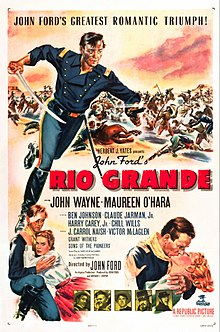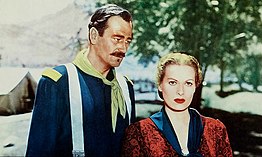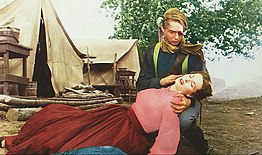I’ll Take You Home Again, Kathleen (Song)
From Wikipedia, the free encyclopedia
| “I’ll Take You Home Again, Kathleen” | |
|---|---|
| Song | |
| Written | 1875 |
| Published | 1876 by John Church Company |
| Genre | Traditional pop |
| Songwriter(s) | Thomas P. Westendorf |
“I’ll Take You Home Again, Kathleen” is a popular song written by Thomas Paine Westendorf (1848–1923) in 1875. (The music is loosely based on Felix Mendelssohn‘s Violin Concerto in E Flat Minor Opus 64 Second Movement). In spite of its German-American origins, it is widely mistaken to be an Irish ballad.
Westendorf, born in Virginia of German parents, was then teaching at the reform school known as the Indiana House of Refuge for Juvenile Offenders in Hendricks County, Indiana. He wrote it for his wife (who was, however, named Jane), who had made a visit to her home state of New York due to homesickness. It’s in the form of an “answer” to a popular ballad of the time, “Barney, Take Me Home Again,” composed by Westendorf’s close friend, George W. Brown, writing under the nom de plume of George W. Persley.
Recorded versions
- A version by Will Oakland on Edison Amberol (catalog 1102) was popular in 1912.
- On 30 January 2011 Jon Boden released a version as part of his A Folk Song A Day project.
- On March 31, 1971 Johnny Cash sang a version of this song on the 56th episode of his television show The Johnny Cash Show.
- Frank Connors (released by Varsity Records) as catalog number 519,
with the B-side “When Irish Eyes Are Smiling“).
- Eugene Conley, American operatic tenor, recorded a version released by London Records.
- Michael Crawford performed the song for his album In Concert in 1998, and also in his concert tour.
- Bing Crosby and John Scott Trotter‘s Orchestra (recorded on July 17, 1945, released by Decca Records as catalog numbers 18721B and 28261,
- both with the B-side “The Bells of St. Mary’s“;
- also as catalog number 23789B with the B-side “Too-Ra-Loo-Ra-Loo-Ral”).
- Merv Griffin (released by RCA Victor Records as catalog number 20-4749, with the B-side “Wild Colonial Boy”).
- Irish tenor Josef Locke recorded a version around the late 1940s.
- Danny Malone (recorded November 27, 1934, released by Decca Records as catalog number 12052A, with the B-side “All That I Want Is in Ireland”).
- Mitch Miller – Favorite Irish Folk Songs – Originally released in 1959 (now Sony BMG MUSIC ENTERTAINMENT – USSM10020418).
- Henry Moeller (released by Gennett Records as catalog number 10069, with the B-side “Sing Me To Sleep”).
- Popular English-born singer Cavan O’Connor recorded and regularly performed the song.
- British novelty pop band Lieutenant Pigeon (released by Decca Records in 1974 as Decca F13486), with the B-side “Big Butch Baby”, reached #3 in Australia.
- Elvis Presley released a version (with overdubbed accompaniment) of him singing to his own piano-playing on the 1973 self-titled album called Elvis on RCA Records, better known as The Fool album.
- He can be seen rehearsing the song by himself in the 1981 documentary This Is Elvis as taken from the footage for the 1970 film That’s the Way It Is.
- He can also be heard performing the same song while in the Army while stationed in Germany in the so-called “Bad Neuheim Medley” of the 1997 RCA CD boxset Platinum: A Life In Music.
- Oscar Seagle (recorded in September 1915, released by Columbia Records as catalog number A-5718, with the B-side “The Bloom Is on the Rye”).
- Vaughan Quartet (released by Vaughan Records as catalog number 725, with the B-side “When Honey Sings an Old Time Song”).
- Tenor and Chorus with Orchestra, Walter Van Brunt. Edison Diamond Disc, 1914, Disc 80160-R. B-side “On The Banks of the Brandywine”.
- Lew White (released by Victor Records as catalog number 27467, with the B-side “On the Wings of Song”).
- Clarence Whitehill (recorded on July 30, 1914, released by Victor Records as catalog number 74425 (a single-sided record); also as catalog number 1275, with the B-side “In the Gloaming”).
- Victor Young and his Orchestra (released by Decca Records as catalog number 28194, with the B-side “My Mother”).
- Slim Whitman recorded a version in 1957, on Imperial 8310, also issued in the UK on London HLP 8403.
- Daniel O’Donnell recorded the song, where it was released on the album, he Daniel O’Donnell Irish Collection, in 1996.
- Scottish tenor Robert Wilson released a version in the late 1940s.
- The Irish Tenors – I’ll Take You Home Again Kathleen
In television
- In the second series episode “Antony’s Birthday” of the British TV series The Royle Family, the family’s neighbour Joe Carroll (played by Peter Martin), normally quiet and retiring, gives a well-received rendition of the song.
- In the Star Trek (TOS) episode, “The Naked Time” (first aired on September 29, 1966), the crew of the Enterprise is affected by a substance, unknowingly picked up from an uninhabited, frozen planet named Psi 2000 about to break up, which brings repressed feelings and behavior to the surface. One crewman, Lt. Kevin Thomas Riley, who “fancies himself a descendant of Irish kings” (as described by Science Officer Spock), locks himself in Engineering and shuts the engines off, causing the ship to decay its orbit toward the disintegrating planet. While the behavior-altering disease spreads throughout the ship and the ship continues to fall toward the planet, Riley adds to the stress by repeatedly singing, “I’ll Take You Home Again, Kathleen” in a half-drunken manner through ship-wide communication speakers.
The Fureys
The Platters
Rio Grande (1950 film)
| Rio Grande | |
|---|---|

Theatrical poster
|
|
| Directed by | John Ford |
| Screenplay by | James Kevin McGuinness |
| Based on | Mission With No Record 1947 story Saturday Evening Post by James Warner Bellah |
| Produced by | Uncredited: Merian C. Cooper John Ford |
| Starring | |
| Cinematography | Bert Glennon |
| Edited by | Jack Murray |
| Music by | Victor Young |
|
Production
companies |
|
| Distributed by | Republic Pictures |
|
Release date
|
|
|
Running time
|
105 minutes |
| Country | United States |
| Language | English |
| Budget | $1,214,899 |
| Box office | $2.25 million (US rentals) |
Wayne plays the lead in all three films, as Captain Kirby York in Fort Apache, then as Captain Nathan Brittles in She Wore a Yellow Ribbon, and finally as a promoted Lieutenant Colonel Kirby Yorke in Rio Grande (scripts and production billing spell the York[e] character’s surname differently in Fort Apache and Rio Grande).
Rio Grande’s supporting cast features Ben Johnson, Claude Jarman Jr., Harry Carey Jr., Chill Wills, J. Carrol Naish, Victor McLaglen, Grant Withers, the Western singing group the Sons of the Pioneers and Stan Jones.
The film is based on a short story “Mission With No Record” by James Warner Bellah that appeared in The Saturday Evening Post on September 27, 1947, and the screenplay was written by James Kevin McGuinness.
Plot
Lieutenant Colonel Kirby Yorke (Wayne) is posted on the Texas frontier with the 2nd U.S. Cavalry Regiment to defend settlers against attacks by marauding Apaches. Colonel Yorke is under considerable pressure due to the Apaches using Mexico as a sanctuary from pursuit, and by a serious shortage of troops in his command. The action of the movie is set in the summer of 1879 (“fifteen years after the Shenandoah“).
Tension is added when Yorke’s son (whom he has not seen in 15 years), Trooper Jefferson Yorke (Claude Jarman Jr.), is one of 18 recruits sent to the regiment. He had flunked out of West Point, but immediately enlisted as a private in the Army. In a private “father-son” meeting in the commanding officer’s tent, Trooper Yorke informs his father that he does not expect, nor want, any special treatment because he is his son. He asks that he be treated like any other soldier—to which the colonel agrees. By his willingness to undergo any test and trial, Jeff is befriended by a pair of older recruits, Travis Tyree (Ben Johnson) (who is on the run from the law) and Daniel “Sandy” Boone (Harry Carey Jr.), who take him under their wings.
With the arrival of Yorke’s estranged wife, Kathleen (Maureen O’Hara), who has come to take the underage Yorke home by buying him out of his enlistment, further tension is added. During the Civil War, Yorke had been forced by circumstances to burn Bridesdale, his wife’s plantation home in the Shenandoah Valley. Sergeant Major Quincannon (Victor McLaglen), who put the torch to Bridesdale, is still with Yorke and is a constant reminder to Kathleen of the episode. In a showdown with his mother, Jeff refuses her attempt to buy him out of the Army by reminding her that not only the commander’s signature is required to discharge him, but his own is needed, as well, and he chooses to stay in the Army. The tension brought about in the struggle over their son’s future (and possibly the attentions shown to her by Yorke’s junior officers) rekindles the romance the couple once felt for each other.
The Apaches attack the fort one night. Many of them are killed by the awakened troopers, but they succeed in freeing their leader, who had been captured at the start of the movie.
Two U.S. marshals from Texas arrive at the post with a warrant for Trooper Tyree’s arrest on a manslaughter charge. Confined to the post hospital, with the connivance of the regimental surgeon (Chill Wills) and Sergeant Major Quincannon, he breaks jail, steals Colonel Yorke’s horse, and goes on the run, intending to stay away until the marshals leave.
Yorke is visited by his former Civil War commander, Philip Sheridan (J. Carrol Naish), now Commanding General of the Military Division of the Missouri, the headquarters responsible for pacifying the Great Plains. Sheridan has decided to order Yorke to cross the Rio Grande into Mexico in pursuit of the Apaches and kill them all, an action with serious political implications, since it violates the sovereignty of another nation.
If Yorke fails in his mission to destroy the Apache threat, he will have to face a court-martial. Sheridan, in quiet acknowledgment of what he is asking Yorke to risk, promises that if it comes to that, “the members of the court will be the men who rode down the Shenandoah with us” during the Civil War. Yorke accepts the assignment.
Yorke leads his men toward Mexico, only to learn that a wagonload of children from his fort, who were being taken to Ft. Bliss for safety – ironic in that the fort was named for a famous mathematician, William Wallace Smith Bliss, and it was failing mathematics that caused Jefferson Yorke to flunk out of West Point – has been captured by the Apaches. Tyree trails the Apaches to their hideout in Mexico, and then rejoins his regiment with the information and a plan to rescue the children. After permitting three troopers—Tyree, Boone, and Jeff—to infiltrate the ruined church in the Mexican village where the Apaches have taken the children, Yorke leads his regiment in an all-out attack. The cavalrymen rescue all of the children unharmed, though Colonel Yorke is wounded by an arrow that he orders Jeff to remove. He is taken back to the fort by his victorious troops, where Kathleen meets him and holds his hand as he is carried on a travois into the post.
After Colonel Yorke recovers, Tyree, Boone, Jeff, Navajo Scout Son of Many Mules, and Corporal Bell are decorated. At the ceremony, when one of the Texas marshals reappears, Trooper Tyree is given a furlough to continue his run from the law, stealing General Sheridan’s horse for the purpose. As the troops pass in review (with the regimental band playing Dixie at the General’s request to please Mrs. Yorke), the movie closes.
Cast
- John Wayne as Lieutenant Colonel Kirby Yorke
- Maureen O’Hara as Kathleen Yorke
- Ben Johnson as Trooper Travis Tyree
- Claude Jarman Jr. as Trooper Jefferson Yorke
- Harry Carey Jr. as Trooper Daniel “Sandy” Boone
- Chill Wills as Dr. Wilkins, Regimental Surgeon
- J. Carrol Naish as General Philip Sheridan
- Victor McLaglen as Sergeant Major Quincannon
- Grant Withers as Deputy Marshal
- Sons of the Pioneers as the Regimental Singers
- Peter Ortiz as Captain St. Jacques
- Steve Pendleton as Captain Prescott
- Karolyn Grimes as Margaret Mary
- Alberto Morin as Mexican Lieutenant
- Stan Jones as Sergeant
- Fred Kennedy as Trooper Heinze
Production
Background
With the completion of Wagon Master, Ford did not want to make another Western. Instead, he wanted to film the Ireland-set romantic comedy-drama film The Quiet Man with Wayne and Maureen O’Hara, but Herbert Yates, the studio president of Republic Pictures, insisted that Ford first make Rio Grande with the same pairing of Wayne and O’Hara because he thought the script of The Quiet Man was weak and that the story was of little general interest. Yates insisted that Rio Grande be made before The Quiet Man, to offset the anticipated losses on that film. When The Quiet Man was eventually released in 1952, though, it vastly out performed Rio Grande by grossing $3.8 million in its first year and giving Yates and Republic Pictures one of the top-10 hits of the year.
Writing
The script for Rio Grande was written by Irish-born screenwriter James Kevin McGuinness. It is based on a short story “Mission With No Record” by James Warner Bellah that appeared in The Saturday Evening Post on September 27, 1947. Parts of the story loosely resemble the expedition of the 4th Cavalry Regiment (United States) under Colonel Ranald S. Mackenzie when they conducted a military campaign in Mexico in 1873.
McGuinness died in December 1950, just four weeks after the film’s premiere in November.
Casting
Former rodeo world champion Ben Johnson had played the leading role in John Ford’s Wagon Master, released seven months before Rio Grande. Johnson would later win the Academy Award for Best Supporting Actor for his performance in Peter Bogdanovich‘s The Last Picture Show in 1971.
Rio Grande was the first of three films directed by Ford starring the pairing of John Wayne and Maureen O’Hara, followed by The Quiet Man in 1952 and The Wings of Eagles in 1957. Wayne and O’Hara also starred together in McLintock! (1963) and Big Jake (1971). Rio Grande marked the uncredited debut of 11-year-old Patrick Wayne, Wayne’s second son.
Filming
The film was shot entirely on location in Moab, Utah, during the extremely hot summer of 1950. Cast and crew struggled with the heat. Sets and stages had to be built in the difficult conditions, while actors were required to perform their scenes in heavy period costumes.
The location shoot was a prime example of Ford’s legendary efficiency—according to Ford scholar Tag Gallagher, Rio Grande was shot in just 32 days, with only 352 takes from 332 camera setups.
Music
The film contains folk songs led by the Sons of the Pioneers, one of whom is Ken Curtis (Ford’s son-in-law and best known for his role as Festus Haggen on Gunsmoke). Bob Nolan had previously serenaded Charles Starrett, lead actor in Rio Grande directed by Sam Nelson in 1938.
Reception
A review by New York Times described it as a “familiar story” that “travels a well-rutted road”. It was also noted for its similarities to the 1935 epic–adventure film The Lives of a Bengal Lancer. Praise was given, though, for the Western-style ballads sung by the Sons of the Pioneers.
On Rotten Tomatoes the film has a 71% rating based on reviews from 17 critics.
Accolades
The film was recognized by the American Film Institute in 2008: AFI’s 10 Top 10: Nominated Western film.
Film appearances
- 1948 For the Love of Mary
- 1950 Rio Grande – Ken Curtis and The Sons of the Pioneers as “The Regimental Singers” singing to John Wayne and Maureen O’Hara.
- 1976 Nickelodeon
- 1991 Hear My Song – performed by Brian Hoey.
Watch The Movie







































































Comments